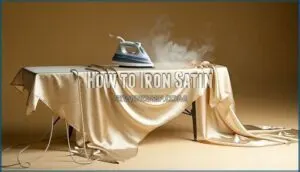This site is supported by our readers. We may earn a commission, at no cost to you, if you purchase through links.

Natural fiber satins like silk and cotton handle diluted bleach solutions better than synthetic versions. Polyester satin will turn an ugly yellow that you can’t fix, while nylon often suffers permanent damage.
Before you even think about bleaching, check that care label and do a patch test on a hidden seam. Mix a weak bleach solution—think one part bleach to ten parts water—and test it first.
Cotton satin responds best to gentle oxygen bleach rather than harsh chlorine versions. The secret lies in understanding what you’re working with before you start the process.
Table Of Contents
Key Takeaways
- You’ll need to identify your satin’s fiber content first—natural fibers like cotton and silk can handle gentle bleaching, but synthetic polyester will turn permanently yellow
- Always do a patch test on a hidden seam with a diluted solution (1 part bleach to 10 parts water) before treating the entire garment
- Use oxygen bleach instead of chlorine bleach for safer results, and never exceed 5-20 minutes of exposure time to prevent fiber damage
- Consider alternatives like professional cleaning if you’re unsure about bleaching your specific satin fabric
Understanding Satin
Before you begin bleaching your satin garment, you need to understand what you’re working with. Satin isn’t a fiber type – it’s a weave pattern that creates that signature glossy surface we all recognize.
This luxurious fabric can be made from various materials, and knowing your satin types makes all the difference in fabric care. Silk satin offers natural luster and breathability, while polyester satin provides durability at a lower cost.
Nylon and rayon versions balance affordability with shine. Cotton satin combines softness with breathability. Each fiber properties respond differently to bleach – some tolerate it, others don’t.
The weave structure affects how satin drapes and stretches. Some varieties feel rigid, others flow like liquid. This textile science matters because different constructions require specific satin care tips.
Always check care labels first – they’re your roadmap to successful satin whitening methods without damage.
How to Wash Satin
Washing satin properly requires gentle handling and the right techniques to preserve its delicate fibers and lustrous finish.
You’ll need specific supplies and methods to clean satin without damaging its smooth texture or causing permanent stains.
Washing Supplies
Before washing satin, you’ll need specific supplies that protect this delicate fabric.
Think of it as assembling your fabric care toolkit – each item plays a vital role in maintaining satin’s luxurious appearance.
Here are three essential washing agents you’ll need:
- Mild detergents: Choose gentle, chemical-free laundry detergent formulated for delicate fabrics rather than harsh washing agents that damage satin fibers.
- Stain removers: Select oxygen bleach or nonchlorine bleach products for laundry pre-treated stains, avoiding chlorine bleach for satin completely.
- Fabric softeners: Use sparingly to maintain satin’s natural sheen without coating fibers excessively.
When caring for satin, understanding satin fabric care is essential to prevent damage and maintain its appearance.
Tools You’ll Need
Before handling your satin project, gather the right tools to guarantee success.
You’ll need protective gloves to shield your hands from harsh cleaning solutions and bleach damage prevention.
A measuring cup helps create precise bleach for satin mixtures, while fabric testers let you check compatibility first.
- Protective gloves – Essential for handling bleach alternatives and cleaning solutions safely
- Measuring tools – Cups and spoons for accurate satin bleach instructions ratios
- Testing materials – Small fabric pieces to test how to bleach satin reactions
- Satin brushes – Soft tools for gentle handling during the satin fabric bleaching guide process
Having these essentials ready makes your bleaching project smoother and safer.
Using satin cleaning gloves is vital for protecting your hands from bleach and harsh chemicals.
Removing Stains on Satin
Quick action beats hesitation when tackling satin stain removal.
Time beats hesitation in satin stain battles
Pre-treat spots immediately using gentle techniques that won’t damage delicate fibers.
Test cleaning solutions on hidden areas first to prevent fabric damage or discoloration.
Effective stain removal often requires specialized satin stain solutions.
| Stain Type | Treatment Method |
|---|---|
| Oil/Grease | Cornstarch absorption, then gentle dish soap |
| Wine/Juice | Cold water rinse, white vinegar solution |
| Makeup | Micellar water or makeup remover |
| Sweat/Deodorant | White vinegar and water mixture |
Satin care requires patience and the right approach.
Spot cleaning works best for localized stains, while color restoration needs professional attention.
Always blot—never rub—to avoid spreading stains deeper into the fabric’s weave.
Washing Satin
After successfully removing stains from your satin, proper washing techniques become your next priority. The right approach protects the delicate fibers while maintaining that coveted shine.
Start by preparing lukewarm water in a clean sink or basin. Hot water damages satin fibers, while cold water won’t effectively remove dirt. Add a small amount of mild detergent—harsh chemicals strip satin’s natural luster.
Follow these three essential steps for ideal satin care:
- Gentle agitation – Swish the fabric lightly to create suds without aggressive rubbing
- Thorough rinsing – Use cool water to remove all soap residue completely
- Careful moisture removal – Squeeze gently instead of wringing to prevent fiber damage
Submerge your satin item and massage it softly with your fingertips. This gentle cycling motion lifts dirt without compromising the weave structure. For effective stain removal, focus on problem areas with light circular motions.
Never twist or wring satin—this destroys the fabric’s integrity. Instead, press excess water out gently before air drying flat on a clean towel.
How to Iron Satin
Proper ironing keeps your satin looking smooth and luxurious without damaging the delicate fibers.
You’ll need to use the right temperature settings and techniques to avoid scorching or creating unwanted shine on this sensitive fabric, ensuring your satin remains in good condition by following these delicate care instructions.
Preparing The Iron
Before ironing satin, proper Iron Maintenance starts with checking your soleplate for residue buildup that could snag delicate fibers.
Clean it thoroughly with a damp cloth, then adjust Steam Settings to low or turn off steam entirely—excess moisture can waterspot satin’s lustrous surface.
Set Iron Temperature to the lowest heat setting, typically silk or synthetic, depending on your satin’s composition.
This careful preparation prevents scorching and maintains satin’s signature sheen. Understanding satin fabric types is essential for the ironing process to avoid damaging the material, ensuring delicate fibers are protected.
Ironing Satin Gently
It’s easy to feel like you’re walking a tightrope when Satin Ironing is on your to-do list.
Protect those delicate fibers and keep your satin care routine on point with these steps:
- Use a press cloth for Fabric Protection—cotton or muslin works best.
- Set your Iron Temperature to low, avoiding scorched or melted spots.
- Try Gentle Steaming from a safe distance for smooth Satin Finishing.
Remember, a gentle detergent keeps fabric softness, and never let water droplets linger—they leave marks.
Hanging Up Satin
Once you’ve finished ironing your satin, proper Hanging Methods become your next priority.
Choose padded hangers instead of wire ones to prevent shoulder dimples and fabric stress.
For Satin Storage, use Satin Clips at the waistband for skirts or pants, avoiding shoulder areas on delicate pieces.
Your Closet Organization should include breathable garment bags for long-term storage.
When using safe bleaching techniques or learning how to bleach satin fabric, proper hanging during the drying process prevents new wrinkles from forming.
Remember, satin fabric bleaching guide success depends on gentle handling throughout every step, including post-treatment care.
Can You Bleach Satin?
After ironing your satin to perfection, you might wonder whether bleaching can tackle stubborn stains. The answer depends entirely on your satin’s fiber content.
Not all satin can handle bleach – know your fabric before you risk it
Bleach safety starts with understanding your fabric. Polyester satin and bleach don’t mix – the fibers turn an unsightly yellow regardless of the original color. However, natural fiber satin like silk or cotton can handle careful color removal with proper technique.
Here’s what determines satin fabric bleaching guide success:
- Fiber identification – Check care labels to identify polyester content
- Fabric damage prevention through spot testing hidden areas first
- Safe bleaching techniques using diluted solutions only
- Bleach alternatives like oxygen bleach for gentler treatment
Satin care requires patience. You can’t rush the process or skip the test patch step. Professional cleaners often recommend avoiding chlorine bleach entirely, as fabric bleaching safety means accepting that some stains might be permanent rather than risking complete garment destruction.
When you bleach satin fabric, remember that results vary substantially based on weave density and fiber quality.
Preparing to Bleach Satin
Anyone can jump into bleaching satin without proper preparation, but that’s like driving blindfolded—you’re asking for trouble. Before you bleach satin fabric, you’ll need to identify what type of satin you’re working with and gather the right supplies for fabric bleaching safety.
Start with fabric testing on a hidden area to check bleach compatibility. Different satin types react differently to chemical treatments, so this step prevents costly mistakes.
| Essential Items | Purpose |
|---|---|
| Test fabric piece | Verify bleach tolerance safely |
| Rubber gloves | Protect skin from chemical burns |
| Well-ventilated area | Prevent harmful fume inhalation |
Your pre bleaching checklist should include bleach alternatives like oxygen bleach or color removers, which offer gentler options than chlorine bleach. Check care labels first—some fabrics explicitly warn against bleaching. Understanding satin care methods is vital for maintaining the fabric’s quality and appearance.
This fabric bleaching guide emphasizes bleach safety above everything else. Having proper ventilation, protective gear, and backup cleaning methods guarantees you’ll achieve the results you want without damaging your precious satin pieces.
Steps to Bleach Satin
Now you’re ready to start the actual bleaching process with your prepared workspace and materials.
The key is working methodically through each step to achieve even results without damaging your satin fabric.
Creating a Bleach Solution
With your supplies ready, creating the right bleach solution is your next step. Getting the bleach concentration just right protects your satin while achieving the results you want.
Here’s how to mix your solution safely:
- Choose oxygen bleach over chlorine bleach – it’s gentler on satin fibers and won’t cause yellowing
- Mix one part bleach with ten parts warm water – this dilution prevents fabric damage while maintaining effectiveness
- Work in a ventilated area wearing gloves – proper safety precautions protect you from fumes and skin contact
Always prepare fresh solution immediately before use, as bleach loses potency quickly. You can find various oxygen bleach products online for different needs. Never mix bleach with other cleaners, and dispose of leftover solution properly according to local guidelines.
Submerging Satin in The Solution
Carefully lower your satin fabric into the bleach solution, guaranteeing complete submersion.
Gently stir with a wooden spoon using circular motions to promote even solution penetration throughout the fibers.
This stirring technique prevents blotchy results and guarantees uniform bleaching.
Satin’s delicate nature means you should consider professional care options to avoid damage.
Monitor the fabric closely during immersion time, watching for color changes that indicate the chlorine bleach or oxygen bleach is working effectively on your satin fabric.
Allowing Satin to Sit in Solution
Third, you’ll monitor the soaking duration carefully while your satin fabric sits in the bleach solution.
Here’s what you need to track:
- Solution Temperature – Keep the mixture at room temperature for consistent results
- Agitation Methods – Gently stir every minute using a long spoon for even penetration
- Over-Bleaching Risks – Watch for fiber weakening or unexpected color changes
- Timing Control – Limit exposure to 5-20 minutes maximum depending on fabric type
Chlorine bleach works faster than oxygen bleach, so adjust your timing accordingly.
Bleaching satin requires patience—rushing leads to damage.
Rinsing and Drying Satin
After your satin fabric sits in the bleach solution, remove it promptly to prevent over-processing.
Immediately rinse with cool water – never hot water, which damages satin fibers. Rinse water temperature should stay below room temperature for ideal satin maintenance.
Gently swish the fabric until all bleach traces disappear, then squeeze out excess water without wringing.
When comparing drying methods, air drying beats machine drying every time for preserving satin’s delicate structure.
Lay flat on clean towels away from direct sunlight. Air drying duration typically takes 6-12 hours.
This prevents wrinkles naturally while maintaining the fabric’s signature sheen through proper post-rinse treatment, ensuring delicate structure and proper post-rinse care for satin fabric, with ideal satin maintenance.
Tips for Bleaching Satin
When bleaching satin fabric, proper preparation prevents disappointing results.
Success hinges on understanding your fabric’s composition and following these essential bleaching techniques:
- Fabric testing: Always test bleach concentration on a hidden area first—this small step saves your entire garment from potential disaster
- Safety precautions: Wear gloves and work in ventilated spaces to protect yourself from harsh chemicals
- Bleach alternatives: Consider oxygen bleach or color removers designed for delicate fabrics instead of chlorine bleach
- Post-bleach care: Rinse thoroughly with cold water immediately after bleaching to halt the chemical process
These precautions guarantee you’ll achieve your desired results without damaging your precious satin.
Alternatives to Bleaching Satin
Smart alternatives exist when bleach isn’t your satin’s best friend. Professional cleaning services use hydrocarbon solvents that safely tackle tough stains without compromising your fabric’s luxurious texture. These specialists handle 90% of luxury satin apparel because they understand the delicate dance between effective cleaning and preservation.
For home solutions, enzyme detergents work like tiny molecular mechanics, breaking down protein-based stains naturally. Color-safe options protect your satin’s original hue while lifting discoloration. Gentle washing with pH-neutral soaps prevents yellowing and maintains that coveted sheen.
Natural stain removal methods offer surprising effectiveness. Diluted hydrogen peroxide shows 65% stain reduction without fiber damage, while oxygen bleach provides nonchlorine alternatives for stubborn spots. For tougher stains, consider that you can use OxiClean if applied carefully.
- Professional dry cleaning – Commercial-grade solvents remove set-in stains while preserving luster
- Enzyme-based treatments – Target specific stain types without harsh chemical damage
- Natural whitening agents – Lemon juice combinations lighten stains gradually and safely
Frequently Asked Questions (FAQs)
What are the potential consequences of using bleach on satin shoes?
Using bleach on satin shoes can cause permanent yellowing, fabric weakening, and loss of sheen. You’ll risk creating blotchy discoloration, holes, or complete fiber breakdown, especially with synthetic materials.
Is it possible to completely remove dye from satin fabric?
Completely clearing color from satin can’t happen—you’ll get lighter shades, not total transparency.
Natural fiber satins respond better to bleaching than synthetic ones, but complete dye removal remains impossible without destroying the fabric.
How should satin be rinsed after bleaching?
Rinse your satin thoroughly with cold water immediately after bleaching to stop the chemical process. Swish it gently, then soak in fresh cold water to remove all bleach residue completely.
Are there any alternatives to bleaching satin fabric?
You’ve got several gentle alternatives that won’t damage your delicate satin.
Try oxygen bleach, white vinegar, lemon juice, or club soda for stain removal.
These natural options preserve fabric integrity while still tackling discoloration effectively, using methods like lemon juice.
What happens to satin color after bleaching?
Like playing with fire, bleaching satin transforms its color unpredictably. You’ll see lightening or complete color removal, but synthetic fibers often yellow permanently while natural fibers bleach more evenly.
Can you bleach satin wedding dresses safely?
Bleaching satin wedding dresses isn’t recommended since most contain polyester or silk fibers that’ll turn yellow or get damaged.
You’d need to identify the exact fabric first, then test a hidden area before attempting any bleaching process.
Does bleaching ruin satins natural shine permanently?
Think of satin’s shine like a delicate mirror—bleach acts like sandpaper, permanently dulling that lustrous surface. You’ll lose satin’s signature sheen forever once bleach breaks down the fiber structure.
How long does bleached satin take to dry?
Air-dried satin typically takes 2-4 hours to dry completely, depending on fabric thickness and room humidity.
You’ll want to lay it flat on clean towels, avoiding direct sunlight to preserve that silky sheen you’re after.
Can you reverse bleach damage on satin?
Unfortunately, you can’t reverse bleach damage on satin fabric. Once bleach strips the color or weakens the fibers, that damage is permanent and irreversible, leaving you with a forever-changed garment.
Conclusion
Don’t put all your eggs in one basket when deciding whether you can bleach satin—the fiber content makes all the difference.
Cotton and silk satins can handle gentle bleaching with proper technique, while synthetic versions like polyester will turn yellow permanently.
Always test first, use diluted solutions, and consider oxygen bleach over chlorine.
Master how to bleach satin safely by understanding your fabric’s needs, and you’ll avoid costly mistakes that ruin delicate garments, by using the right technique and being mindful of the fabric’s fiber content.















